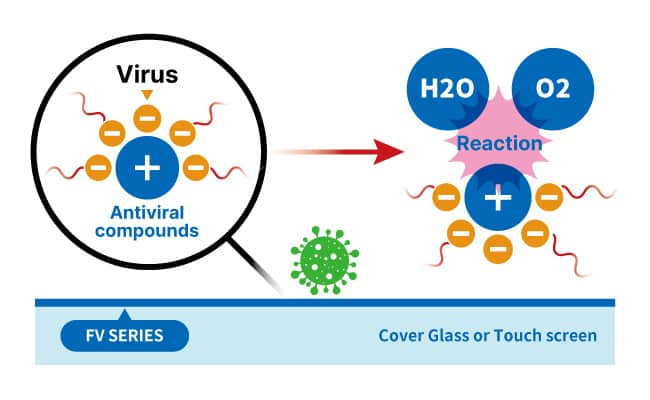
Anti-Viral/ Bacterial Film Lowering the Risk of Viral Infection Support:Resistive TypeCapacitive Type The anti-virus anti-bacterial film, which reduces the risk of infection from touchscreens touched by many people, can be easily installed by simply attaching it to the touch panel operation surface. Definition of anti-bacterial "Inhibiting bacterial growth on product surfaces". The use of antibacterial processed products can reduce the spread of bacteria. Reducing the number of specific viruses on products Having no cell, virus is just a structure and its size is about one thousandth of bacterium. Virus cannot be killed since it is not living. Therefore, it is necessary to decompose its structure and inactivate its capability to get into a cell in order to make a virus ineffective. Virus will be Attracted and Fixed Anti-viral agent (metal) with a positive charge will act on a virus with a negative charge. The virus and anti-viral agent will be attracted by the static electricity level, fixed, and cannot be separated. The antiviral agent will react with the moisture in the air. Virus will be Inactivated by Active Oxygen The antiviral agent (metal) will react with the moisture in the air to generate active oxygen (OH radical). Because of the high oxidizing power of the active oxygen, it will denature and inactivate the proteins in the viruses. Viruses will become dysfunctional. SIAA Mark has been Obtained FV series is certified by SIAA* (the Society of International sustaining growth for Antimicrobial Articles) for its anti-viral and anti-bacterial functions. Anti-viral Performance FV series is effective against both types of viruses with and without envelop. The number of viruses decreases by more than 99% in test method conforming to ISO 21702*. * ISO21702:2019: Measurement of anti-viral activity on plastic and other non-porous surfaces. Anti-bacterial Performance The growth of bacteria shall decrease by more than 99% in the test method conforming to ISO22196* * ISO22196:2011: Measurement of antibacterial activity on plastics and other non-porous surfaces.